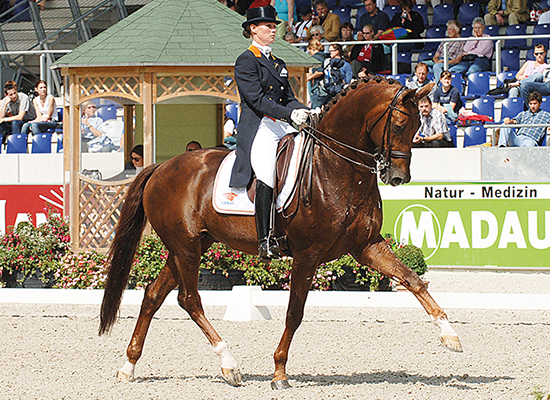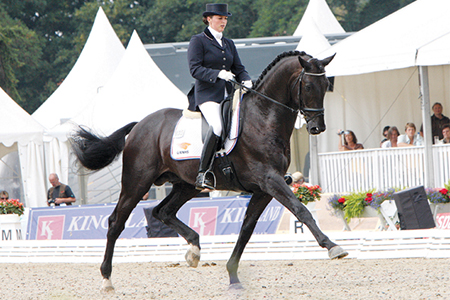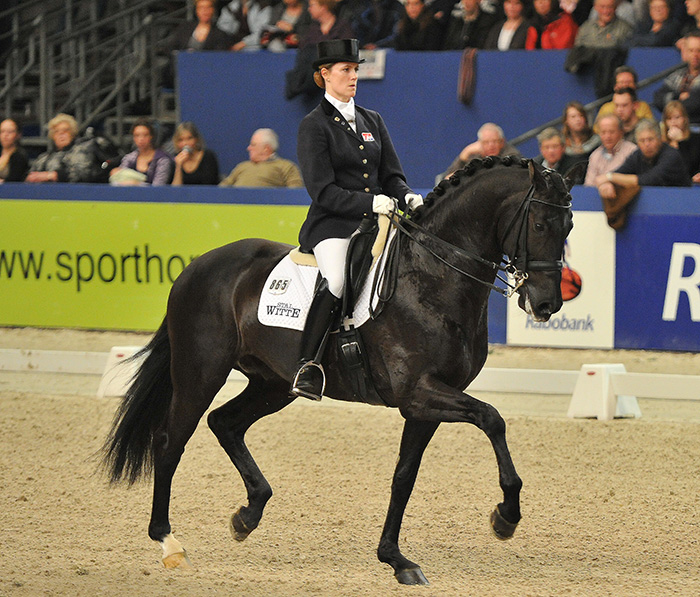1991 – 2020 170 cm Chestnut
Breeder: H. van Helvoirt
Jazz was a second generation Grand Prix dressage horse, following in his father, Cocktail’s footsteps – and like Cocktail, there is not a lot that says ‘dressage’ about the pedigree, he comes from an era when specialisation was just beginning, and breeders tended to breed for an all-round horse, and let the talents of the horse decide it’s career.
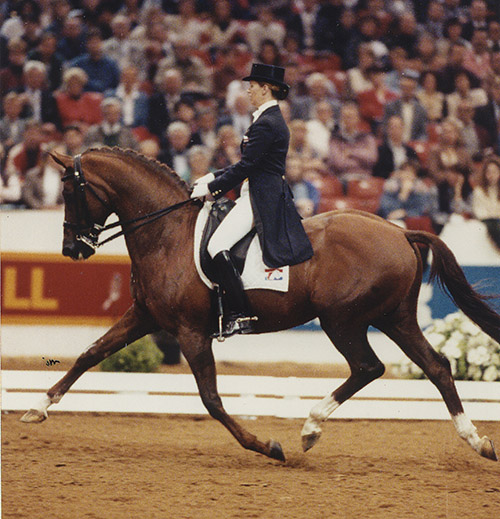
Cocktail competing with Anky van Grunsven
Jazz is the product of the breeding program of Huub and Tiny van Helvoirt, a program that began with mares by Amor.
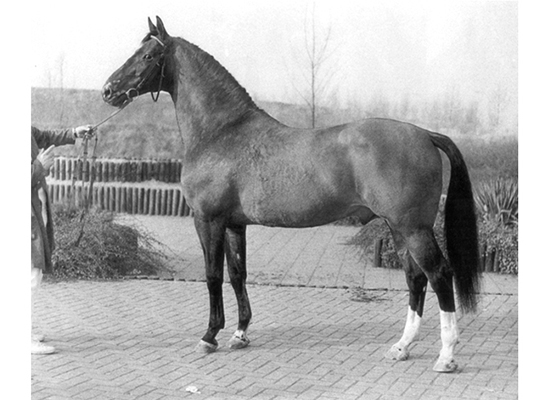
Amor – the Holsteiner Stallion (Herrscher / Loretto) was imported to Holland in 1961
Mr van Helvoirt explained to Karin de Haan for her article, Endy – the mare makes the difference (iDs/6):
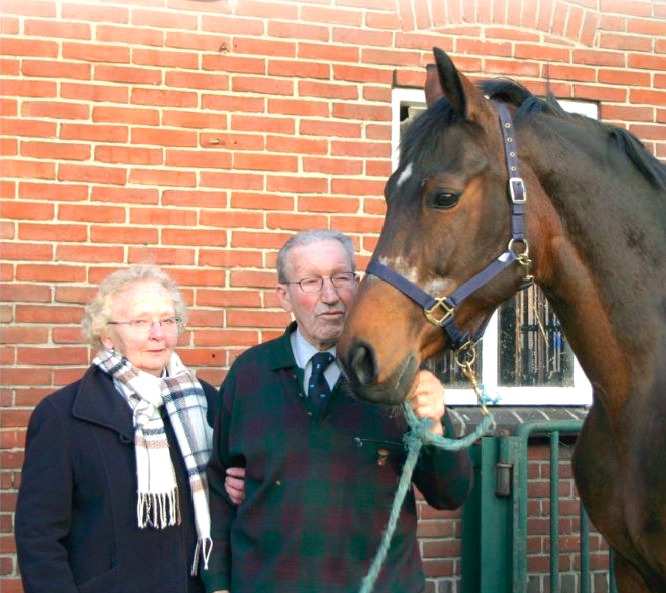
Huub and Tiny van Helvoirt and their mare, Endy
“At the time we were looking for good Amor foals that we could use in our breeding business. We were pretty big fans of Amor because many of his offspring are good movers, which is why they often finished first at the selections. We’ve always considered movement very important in our breeding program.”
“The Amor foals were up north, so that’s where we went. The first foal we looked at that day was Warmante, Jazz’s grand dam. Initially we dismissed her because we were concerned that she wouldn’t grow big enough: Amor could sire a small foal now and then. We’ve always considered sufficient size important. We looked at more foals at several locations that day, and our last stop was Mr Lucassen’s place in Wehl. That’s where we found Wendy. We liked her and bought her immediately. On our way home, we started talking about Warmante again, the first foal we saw. We then decided to buy her too so that the two foals could grow up together.”
Between them the two mares would be responsible for the KWPN stallions, Zudenwind, Zhivago, Viento Uno W and Jazz – and they need not have worried about Warmante’s height: “Interestingly enough, Warmante and Wendy ultimately ended up the same height,” Mr van Helvoirt recalls. “So you see, you can’t predict exactly how a foal will turn out. Wendy grew to 16 hands, which is actually a bit smaller than we have expected. As far as the stallions we choose for our mares, we always look for those that pass on size to their offspring.”
Warmante was out of Parmante who was by the Thoroughbred, Pericles, and out of a mare by a son of that other giant of early Dutch breeding, the French import, L’Invasion.
The van Helvoirts bred Warmante to Ulster (by Nimmerdor) to produce Charmant, who bred to Cocktail, produced Jazz.
Master trainer and KWPN Stallion Commission member, Johan Hamminga, rode Jazz during his performance test in 1994:
“I rode Jazz in the performance test for the first three weeks.” Johan told me, “He was afraid, tense, not relaxed. For the first two weeks I rode him in a very small arena, starting just five metres by ten metres, and each day, we made the arena a little bigger. Then he started to trust the rider. That is very important with a horse, when a horse trusts you, he relaxes, and then you can get something from him. With Jazz at first, he didn’t trust anyone, and we had to make a good relationship. After 14 days he felt better, and I gave him to one of my riders.”
“Jazz was lucky to get through the performance test, every day there was discussion about him – yes / no / yes. But after the first three weeks he showed what a big mover he was, he was a good horse, and now he is the stallion of the century with eighty horses in Grand Prix.”
Finally Jazz received 9 for the riding test, 9 for the training report, 9 for stable behaviour, 8 for temperament, but 5’s for jumping for a 71 total. Walk – 8, canter – 8.5, trot – 9.5.
And the comment:
Honest, reliable, temperamental, likes to look at everything. Very willing to work and works well. The walk is easy with a long stride. He carries himself well in the trot, has very good use of the foreleg and has sufficient power. The canter is sufficient in scope and carriage but it should be more powerful. He raises the forehand during dressage and he works well. He has a great deal of talent for dressage and gives his rider a good feeling.
He has sufficient take-off during jumping but shows little bascule. He does not show much scope and does not finish the jump from behind. Has little talent for jumping and gives his rider a moderate feeling. Stall and handling behaviour is normal.
According to Jaap Werners, who gave him his breeding license: “He stood out because of his amazing forehand, high legs, withers/shoulders and his hind leg. And of course he had an amazing trot. And that he has Cocktail as his sire, was a plus. In the terminology of then, Jazz wasn’t a true sire. He was narrow and barely met the qualifications for a breeding stallion in the old fashioned philosophy. But he had so much charisma, ‘presence’ as they say it in England. You didn’t forget him.”
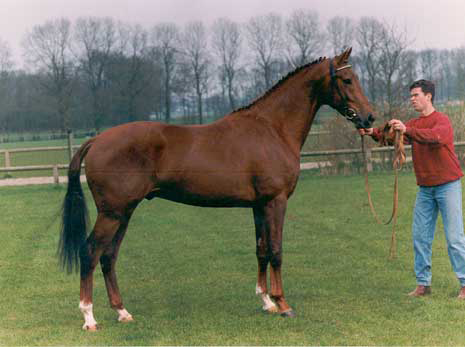
Jazz as a young horse
In 1995 the report on his foals noted:
Jazz presented a collection of sufficient to more than sufficiently developed riding type foals that are refined. The collection was very uniform, both in regards to shape and to movement. The head is expressive and well formed. The neck has good shape and length but the transition into the wither/shoulder formation should be smoother. The wither should be more developed but the length is very good. The shoulder has good length and placement. On the whole the back has good shape and muscling, the loins are sometimes a little dense. The croup has good shape and is sufficient, the quality is good. The transition of the cannon to the hock is often sharp and the hock should be better developed. The walk is good and sufficient in scope. The foals carry themselves well in the trot, show rise in the front and there is takt and scope with good use of the hindleg. They set their neck and they should relax more through the topline. The foals seldom jump into the canter. One foal that was inspected at home fit into the picture. Most of the mares had good quality. The veterinarian noticed a curb in two cases.
In short: a uniform collection of riding type foals with refinement and sufficient to more than sufficient development. They like to trot and show rise in the front. They also have taKt and scope.
Jazz commenced his career as an international Grand Prix competitor in 2001 with Tineke Bartels who loved the horse:
“There is not a mean bone in Jazz’s body,” Tineke told Claartje van Andel, for her article, Jazz: One in a million (IDS international, March 2011) “What’s more, his strength is that he’s so positive. That’s nice, a positive horse! He makes every day enjoyable.”
Which wasn’t really the opinion of many early in his career, they thought the stallion was at best ‘spooky’ at worst ‘crazy’.
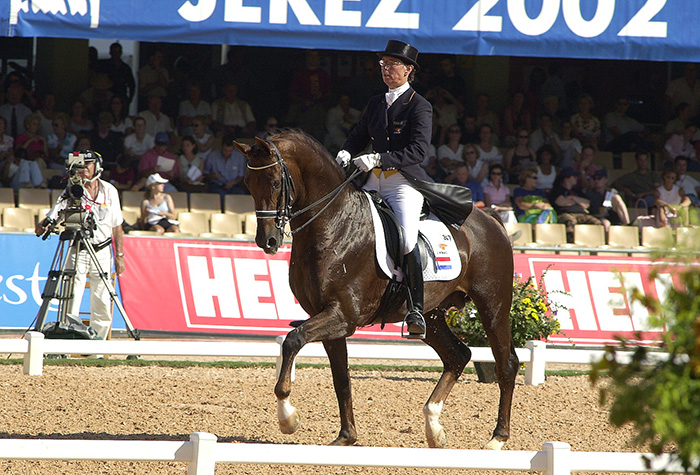
Tineke competing at the 2002 WEG in Jerez with Jazz
Tineke disagrees: “In those years, people weren’t accustomed to the positive aspect of a sensitive horse. We also got negative publicity, That’s why I focussed on a ballet show with dances and a torch show back then just to prove that Jazz didn’t have a mean bone in his body and that he was actually a fantastic animal. Jazz didn’t work for me; no, he worked purely for himself. He’s an arrogant guy who’s full of himself. Jazz just played with the ballet show dancers. Nowadays, we don’t think it’s a problem if a fantastic horse is occasionally spooky, like Parzival and Anky’s Salinero used to be. I had to do some work to get that concept across.”
“People really started taking Jazz seriously as a top sire when he proved he could produce one Grand Prix horse after another. Of course, a lot of Jazz offspring mature late, and they’re often easily distracted.”
When Jazz moved to Broere stud, he competed with Kirsten Beckers who also enjoyed riding the chestnut:
“He was so nicely schooled, truly a professor. I really learned the feel for the piaffe-passage transitions from Jazz. He can collect like no other. And all that ‘go’! I can ride all my horses better because of the feeling Jazz gave me.”
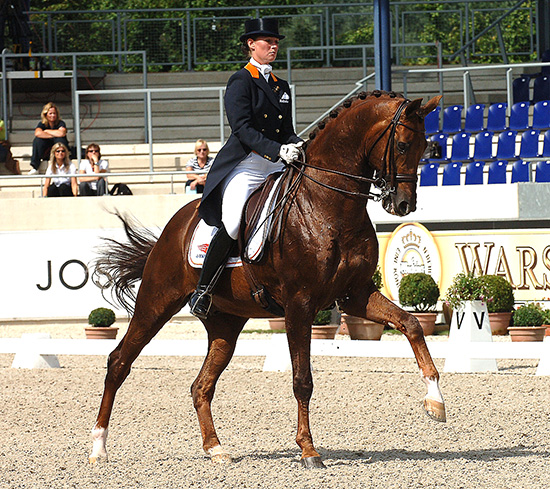
Kirsten Beckers and Jazz
Jazz had fourteen licensed sons in Holland and 47 licensed grandsons.
A world champion by Jazz – Westpoint at Verden 2009
As a sire, Jazz has produced the PAVO (young horse) champions, Broere Norway, Patser, Robin Hood and Wynton. His son Westpoint (out of a Michelangelo / Le Mexico mare) was World Champion Young Dressage horse at Verden in 2009.
In 2007, Jazz was granted the Preferment predicate by the KWPN.
Jazz was ranked 1st in the world on the WBFSH standings for 2008/9, for the third year running but on the 2013 standings, had dropped to 3rd place. His 2013 points were contributed by 20 horses, the most successful by far being Parzival with almost 3000 points, followed by Tango (1732), Unlimited (1670) and Wynton (1652).
On the 2020 WBFSH rankings, Jazz has dropped from 1st in 2019 to 2nd, while his son, Johnson, moves from 2nd to 1st.
Parzival with Adelinde Cornelissen won the GP Special at the 2009 Euro Champs(pic) and were part of the gold medal winning Dutch team and after collecting many more European and Olympic Games, medals, retired at the Rio Olympic Games
On the 2014 KWPN dressage stallion breeding index, Jazz is in first place with a rating of 196 points (Reliability 97%) in the list of stallions with a reliability of over 90%. Amazingly his son, Chagall D & R, who heads the group of stallions who do not have offspring in competition, has an even higher breeding index – 199! Although the reliability of this index is assessed at 46%.
On the 2021 KWPN rankings for stallions with a reliability of 90+, Jazz is still in first place with a value of 176, his son, Johnson, is 4th on these rankings with a value of 158. Jazz has also been successful as a broodmare sire – Vivaldi in 3rd on these rankings is by Krack C out of a Jazz mare, while Charmeur in 7th, is Florencio over Jazz.
Jazz was the most used Dutch dressage stallion for 2007 with 304 mares. In 2011, he had slipped to 6th place with 100 foals born in 2012. In 2020 the Dutch stallion with the most foals on the ground was Kjento with 303, while the stallion is by Negro, he is out of a Jazz mare. By 2020, Jazz had dropped out of the top five.
At the 2008 Olympic Games, Jazz was represented by Orion in the Canadian team, and the Dutch reserve, Parzival. At the 2012 Games, Parzival was his sole representative. At Tokyo, Jazz had one direct offspring, Carl Hester’s En Vogue while his son, Johnson, had two. Jazz is also the dam sire of Vivaldi (Krack C) who had one representative.
Jazz was discovered by Dutch dressage dealer, Nico Witte, in 2010 he told us:
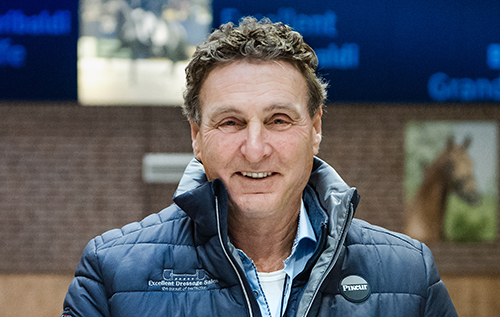
“I bought Jazz as a foal – I saw him first when he was three or four months old, and then I bought a half share of the horse. In my roots, I was a showjumper and rode in the international shows for four, five, six years, and I had some money left, and I bought a foal, and that was Jazz. He was an unbelievable mover, very skinny but he moved really really well. As a three-year-old he was approved by the KWPN. When I first made an advertising prospectus for him at stud, the text was ‘one in a million’ and now he is the number one of the world!”
“I kept him for fourteen years. In the beginning they said, oh the Jazzes are spooky and not reliable for normal riders, but I always said, he is such a talent and the offspring are unbelievable, for the professional riders, he will be top. I think at this moment there are a lot of Jazzes, not only in Holland, but in Germany and Denmark, also in Australia and America, doing really good things – especially in the Grand Prix. Tineke Bartels used to ride him for me and I sold him as a fourteen-year-old, and for me, the story was over, but I still have a lot of Jazzes, because I am really proud to have had Jazz for myself, and to have the Jazz offspring in my stable.”
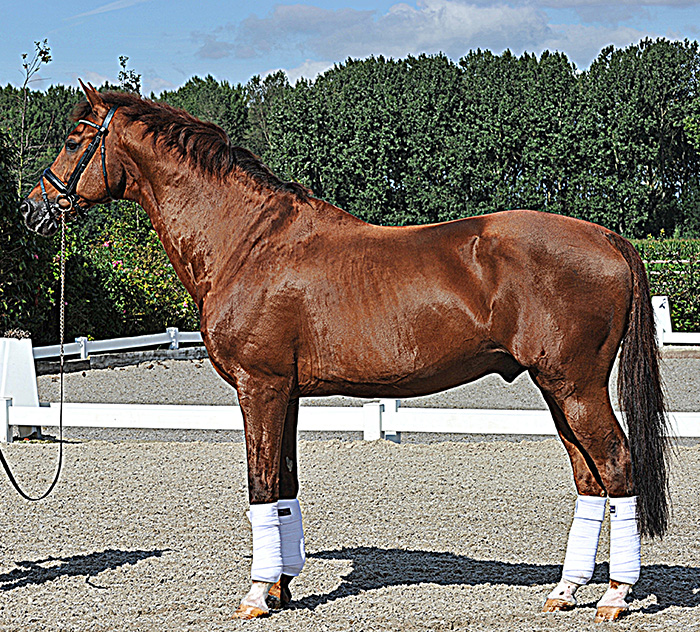
Jazz at home in 2011
What attracted you to him when he was a foal?
“His trot was unbelievable. I said, I have to buy that one, because I had never seen trot like that, and that is how I became a dressage man. I married a dressage wife who was riding Grand Prix and so I became a dressage man, and at this moment I have more dressage horses than showjumpers. I think 80% are dressage horses, and 20% are still showjumpers because I like the showjumpers as well.”
Is there a particular bloodline that Jazz works best with?
“Not really. We have a lot of stallions where you say, oh he needs a high and long legged mare because the stallion has got short legs, or whatever – but I think Jazz will fit on a lot of horses. The only horse you don’t want to use with Jazz is when you have a very spooky, small, electric mare – then don’t use Jazz. But Jazz will also fit in Germany on a lot of horses. I don’t think they have used Jazz enough in Germany, they have horses at this moment that are perhaps lazy in the hind leg, not electric in the hind leg, and if they had tried to use Jazz, five, six, seven years ago, then they would have a better, more modern dressage horse in Germany now, for sure.”
Do you think you can either breed for the top sport or the amateur, but not both?
“I think most Jazzes are not for the amateur, especially the mares, they are more spooky and more electric. For the professionals, or semi-professionals, Jazzes are really top – most of them, not all of them, but most of them.”
Who do you think will prove to be the best son of Jazz as a breeding stallion?
“At this moment it is Wynton. He is a black Jazz out of a Matador mare – that’s the stallion with Kyra Kyrklund, then comes Rubinstein and Welt As – Welt As is the sire of Bonfire from Anky. I think at the moment he is the best approved Jazz son in Holland. He was the winner at the Stallion Show, the winner of the 70 day test, and up to now he won all the stallion competitions, and in the normal sport, he is scoring 70/71% in his tests. He is a very talented horse. I have ten yearlings from Wynton and they are all black and beautiful with unbelievable hindlegs, and an easy character. The German dam line is good for the character… we had a prize giving a few months ago and there were 14 horses on the line, 5000 people started clapping, 13 horses ran away, and Wynton stood like a statue, that is very good, especially for a Jazz.”
Another stallion star by Jazz, Wynton…
For a while it looked as if everyone was going to breed very specialized dressage or jumping horses, but now it looks as if you need a bit of jumping blood in the mare to breed a good dressage horse – Parzival, Totilas – they both have strong jumping blood in their pedigrees…
“Nowadays we have the specialization and I think that is good. I think we have to make sure the dressage horses are built uphill, and they have longer legs, but not too long. I think the specialization is good, but in the beginning, all the dressage horses came out of jumping lines, because they had a good hind leg, and they were strong. But within ten years, I think there will be no more directly jumping mothers in the pedigree anymore in the dressage breeding – it will be in the third or fourth or fifth generation, because of the specialization.”
I discussed Jazz and his likely successor(s) with the late Wim Ernes, the Chairman of the Dressage Selection Committee at the 2014 KWPN Stallion show:
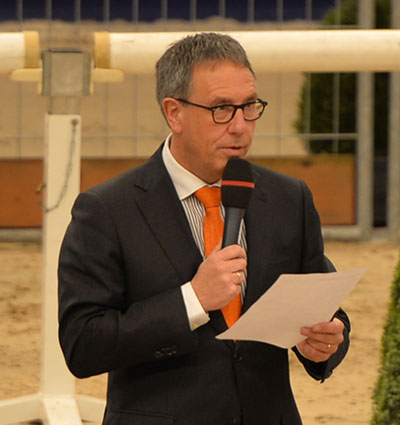
Looking at the wonderful line up of colts by Jazz at the 2014 stallion show, is it a disappointment that there doesn’t seem to be a son of Jazz who is taking over his mantle?
“You never know, because when we approved Jazz, fifteen or sixteen years ago, there was also a lot of discussion about Jazz himself, about his conformation. But I think we, as the KWPN, are lucky that they approved him at that time because he brought us a lot and you never know at this stage which horse will be the new Jazz.”
But would you agree that we didn’t see a group of colts by a son of Jazz that were as good as the colts by Jazz?
“Maybe at this stage, but you never know in the future what they will bring when they start to breed. I think Johnson brought several good horses, maybe not as nice as the Jazz ones, but Jazz is an extraordinary horse because he brought us to the top of the rankings. It is not so easy to find a second Jazz.”
One of the stallions with a lot of colts in the selection was Apache – are you worried that this stallion that did not have a temperament to cope with his Grand Prix career should be so influential?
“That’s a point of discussion. His temperament was always a little bit difficult, but we will see where he ends up. He was a really good small tour horse, he won almost everything in the small tour and at the moment he is making the step up to the big tour. He started once, it was not really a success but okay, Jazz was not always a success in the beginning, we will see what Apache will bring in the future.”
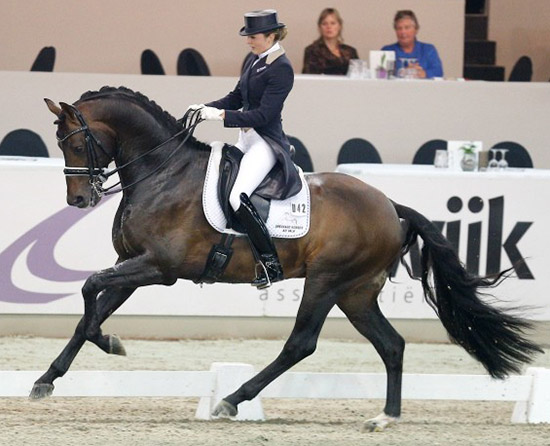
Apache
I thought they had stopped competing him…
“No they competed him a couple of weeks ago in the Inter 2.”
It was good?
“No it was not good, 62 or 63 but this was his first time for a while. I don’t know why he got such a low score, if he was tense or he was scared or whatever, I haven’t spoken yet with the rider.”
Do you see any outcross – will the Ferro influence grow to balance the influence of Jazz? For a while Ferro was in the back seat behind Jazz…
“Now you can see him really coming up. You can see it in the combination with Lord Leatherdale, a really nice colt, and you can see Ferro and his son, Negro, in a lot of lines. They bring a lot of power, activity and strength in the hind legs, and I think that’s very important for a Grand Prix horse.”
The buzz around for another son of Jazz – Vivaldi continues to grow. Former long time head of the KWPN stallion committee, Arie Hamoen remarked to me at the 2017 Young Horse champs when I asked him who was the heir to Jazz:
“Vivaldi is coming up. The rideability is good and the first sons are knocking on the door of Grand Prix. The only problem for Vivaldi is the quality of his semen. Vivaldi’s sons are also knocking, Dream Boy for example. Vivaldi is putting the next step in the line of Jazz.”
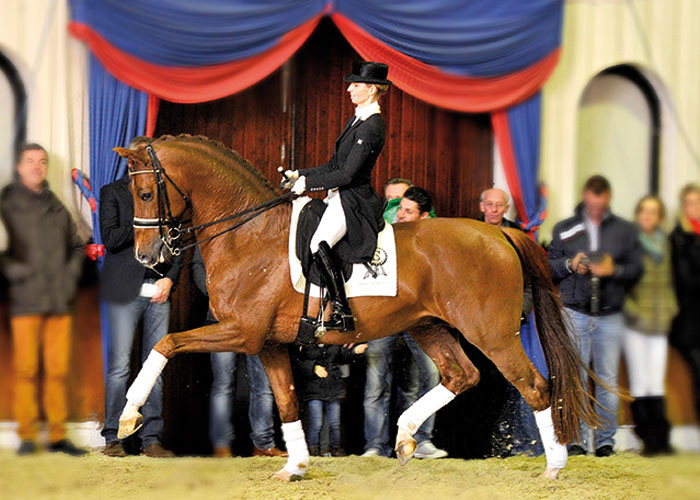
Vivaldi
Eurodressage carried a report on a number of Vivaldi offspring on just one weekend, January 19/21. Hans Peter Minderhoud took out ten-year-old Dream Boy (Ferro) in his first GP at Nieuw en St Joosland, for a win with 78.8%, while at another Dutch show, Bunschoten, Diederik van Silfort brought back small tour star, Expression (Vincent) to win the Inter II with a score of 75.29.
On the 2015/16 KWPN breeding values, Jazz was once again at the top of the list for stallions with a predictability of 90% or more. This time his breeding value is 192 (down two points from three years ago). The statistic I find really interesting on the Dutch values (it’s not there on the German ones) is the number of progeny over the age of four, and the number of them that have competed. For Jazz, the figures are 2807 horses over four, with 990 ‘in the sport’ – that’s a percentage of 35.268, which perhaps backs up the feeling that the Jazz progeny are more likely to be top quality Grand Prix horses for the professionals, than a pleasant pony for Adult Riding clubbers.
The problem with this thesis is that there are only two GP stars who contributed to Jazz’s current 3rd place on the WBFSH dressage sires rankings, but they are mega stars, Johnson and Parzival. The next most successful Jazz is Bonzango (dam sire, Contango) ranked 44th in the world, while four of Jazz’s 15 points earners picked up their placings in competition in Australia, which is not quite the cutting edge of dressage competition.
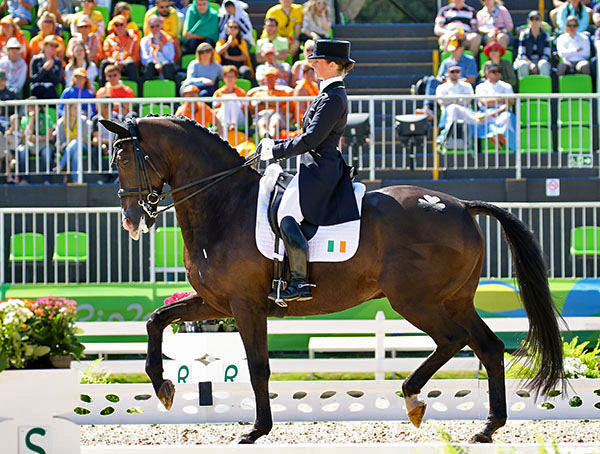
Vancouver at Rio – Photo Kenneth Braddick
On the 2016 WBFSH rankings, Jazz was in 5th place with his most successful competitor, Vancouver K, ridden by Ireland’s Judy Reynolds.
Jazz once again headed the 2016/17 list of KWPN dressage stallions with a reliability of over 90%, with a dressage breeding value of 191 (conformation – 109, free movement – 113, free jumping 97. He has sired 2918 progeny over 4 years, for 1060 competitors – 36.32%. He has a negative OCD value – 97.
On the 2018 German FN rankings for sires of horses in open competition, two horses tied on 164 – Don Schufro (Donnerhall / Pik Bube I, 93%) and Jazz (Cocktail / Ulster, 87%). Jazz is richly represented by the gelding, Vancouver K (Ferro) with Ireland’s Judy Reynolds.
In October 2018, the KWPN released an evaluation of the most successful KWPN stallions ‘in the sport’, and not surprisingly, Jazz topped the list with 666 offspring competing at Z1 level or higher. The next most successful was Gribaldi with 477 followed by Flemmingh with 378. Jazz was also the most successful sire of progeny competing at Grand Prix level with 4.2% or 131 GP representatives. The next best ratio went to Contango with 24 offspring (3.4%). However when the number of progeny were taken into account, the most successful sire of Z1 level progeny was Sir Sinclair (Lord Sinclair / Flemmingh) with 21.9% of his offspring, followed by Jazz’s sire, Cocktail (Purioso / Le Val Blanc), with Jazz in equal 3rd place with a ratio of 21.2%.
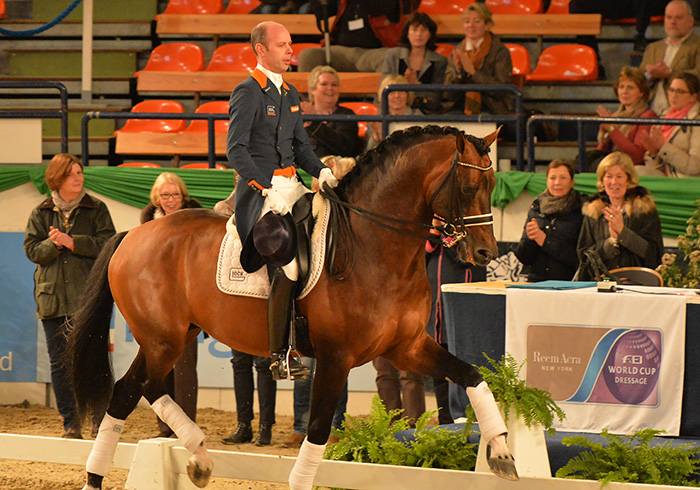
Johnson
On the 2020 WBFSH rankings, Jazz was second to his son, Johnson…
Gemma Alexander examined the strike rate of the top ten WBFSH dressage sires of 2020, and this is what she found:
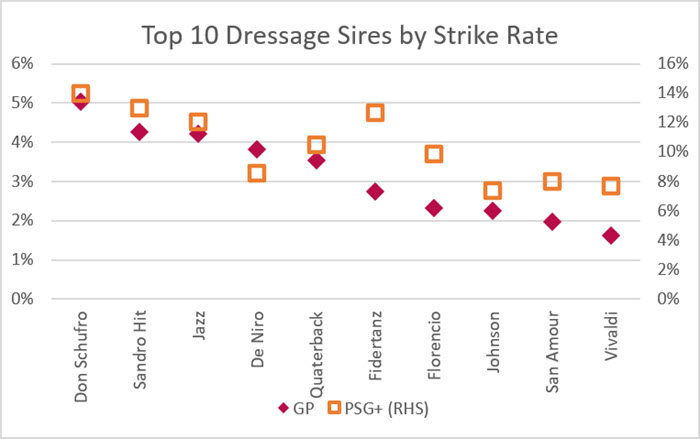
Jazz died in January 2020, the KWPN obituary records:
“No stallion had as much influence on the dressage breeding as Jazz. He was on top of the WBFSH-ranking for years. In the Netherlands, the preferent stallion knew over 3.100 offspring. Thirteen of his direct offspring was approved, from which Johnson is preferent, and Olivi, Wynton and Westpoint were named keur. 43 KWPN stallions carry the Jazz blood in the second generation. At the mare inspections two thirds of this daughters earned the conformation predicate. Jazz gave 99 preferent mares and 62 performance mares.”
From the KWPN registered offspring, 125 were started in the Netherlands and abroad on Grand Prix level, 195 offspring reached the Small Tour level.
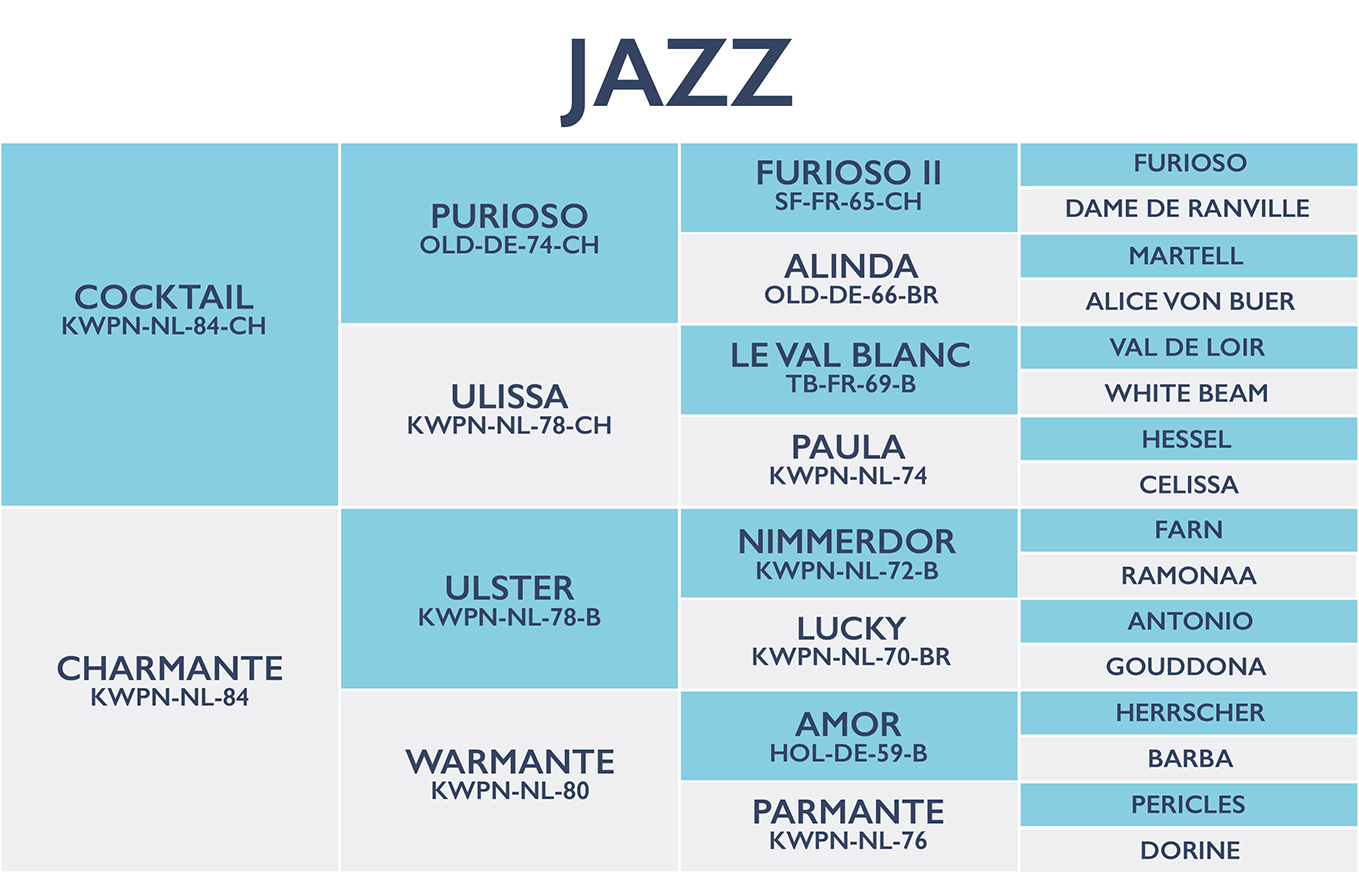
Interested in Jazz blood? Vitalis and Vivaldi are available in Australia: www.ihb.com.au
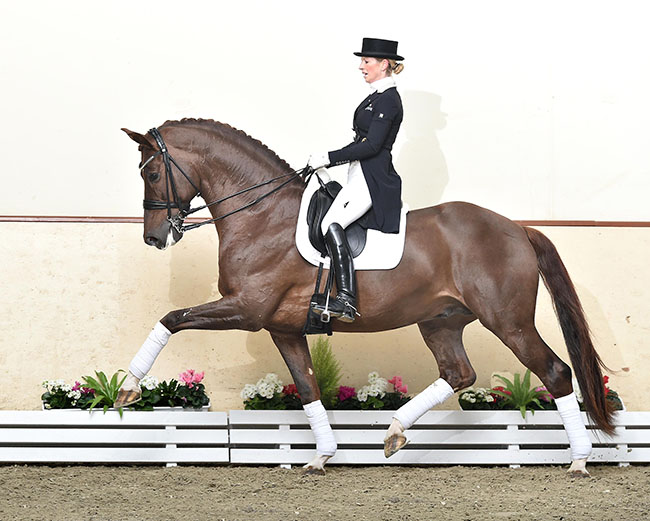
Vitalis



